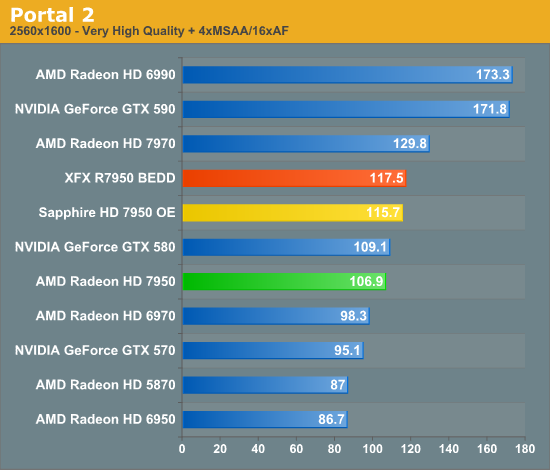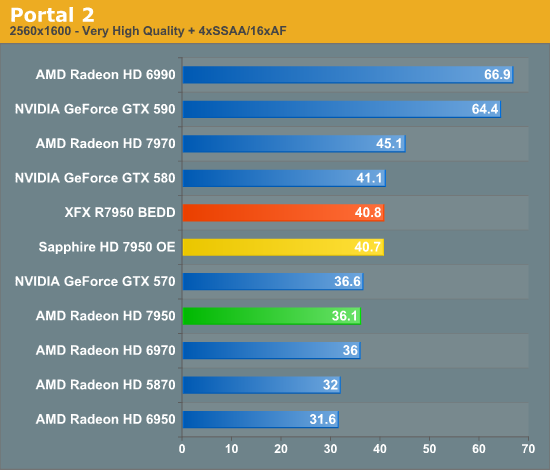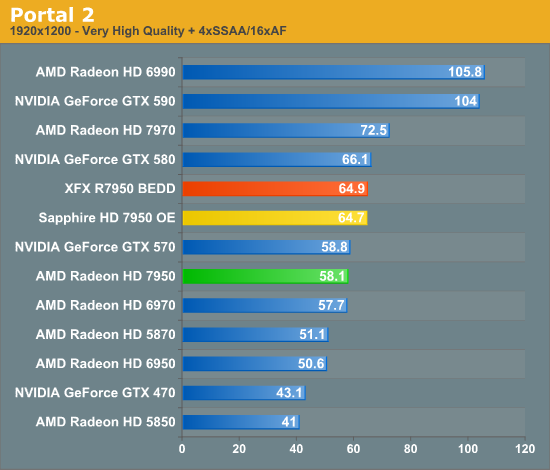AMD Radeon HD 7950 Review Feat. Sapphire & XFX: Sewing Up The High-End Market
by Ryan Smith on January 31, 2012 9:02 AM ESTPortal 2
Portal 2 continues the long and proud tradition of Valve’s in-house Source engine. While Source continues to be a DX9 engine, Valve has continued to upgrade it over the years to improve its quality, and combined with their choice of style you’d have a hard time telling it’s over 7 years old at this point. Consequently Portal 2’s performance does get rather high on high-end cards, but we have ways of fixing that…




Portal 2 ends up being the first game that the 7950 fails to surpass the GTX 580 regardless of the resolution. At 2560 it only trails the GTX 580 by 2%, but at 1920 this widens to 6%, and when we enable SSAA this gap doubles to a surprisingly large 12%. The use of SSAA is especially hard on shader throughput as evidenced by the 20% gap between the 7970 and 7950, though this makes the gap between the 7950 and GTX 580 all the more curious since the 7950 has otherwise proven itself quite capable. Overclocking helps quite a bit here, with the factory overclocked cards gaining 9-13%, but it’s still not enough to push past the GTX 580 once SSAA is involved.










259 Comments
View All Comments
Ryan Smith - Tuesday, January 31, 2012 - link
Thanks. It looks like the culprit is the ShareThis widget we use. I'll have our developers look at it in the morning.Ananke - Tuesday, January 31, 2012 - link
This is a wonderful but too expensive product for the targeted market niche...It will not gain user base by April to attract software developers away from Kepler...Unless NVidia really executes bad /which they will not-internal source/, AMD will be positioned worthlessly by price/performance. Anyway, I admire AMD and I use their products, just their strategy has been lost recently.gnorgel - Tuesday, January 31, 2012 - link
It seems quite pointless to me to benchmark an OC 7950 vs a stock clocked 7970.Anyone who OCs a 7950 would OC his 7970 too. The interesting question is how these 2 OCed Cards perform against each other - this decides whether the the price difference is worth it or not.
kmmatney - Tuesday, January 31, 2012 - link
The best way to get performance per dollar is at this website:http://www.videocardbenchmark.net/gpu_list.php
and sort by "Video Card Value". Using this chart, I bought an HD6850 today, to replace my HD4890 (which is also near the top of the chart). It has enogh performance for me. The performance per dollar is dominated by AMD at the moment.
kmmatney - Tuesday, January 31, 2012 - link
My comment was supposed to be a response to another comment...LuxZg - Wednesday, February 1, 2012 - link
Now all that I wish for is direct comparison between Sapphire card and PowerColor PCS+ version.. Based on techPowerUp's review PowerColor could actually have even better cooling solution (noise/heat) which would really be amazing since Sapphire is already awesome. Make my wish come true Anand! :)And thanks for great review guys and showing off what a nice job AMD & Sapphire did with their new products...
ChosenOne - Wednesday, February 1, 2012 - link
Here is the link for the comparison chart between PowerColor and Sapphire.ChosenOne - Wednesday, February 1, 2012 - link
forgot the linkLuxZg - Thursday, February 2, 2012 - link
Thanks a lot! Seems that Sapphire has the upper hand after all, in both temperatures and noise..Th-z - Wednesday, February 1, 2012 - link
What GCN is able to do in the future is yet to been seen. They need a software ecosystem to support it, like what CUDA is having. In terms of gaming, aside from lower power consumption, the price isn't very attractive. I can see 7970 command a hefty premium, but the price of 7950 would fail AMD to capture some market share. The price they're trying to undercut is a single-GPU flagship part, which also carries a premium over 570, yet 7950 isn't a flagship part.In terms of gaming performance, 7950 is close to 580, which is close to 6970, yet it costs so much higher than 6970. It would be interesting to see how AMD is going to price their VLIW4 7800 and lower parts, because from the specs, they aren't much faster than 6000 series. This time, we probably won't see good performance jump with similar price points even after a major die shrink (remember they even skipped 32 nm). And I think the unnamed NVIDIA source said they was expecting more from 7970, which I think isn't a bluff, considered their Fermi debacle.